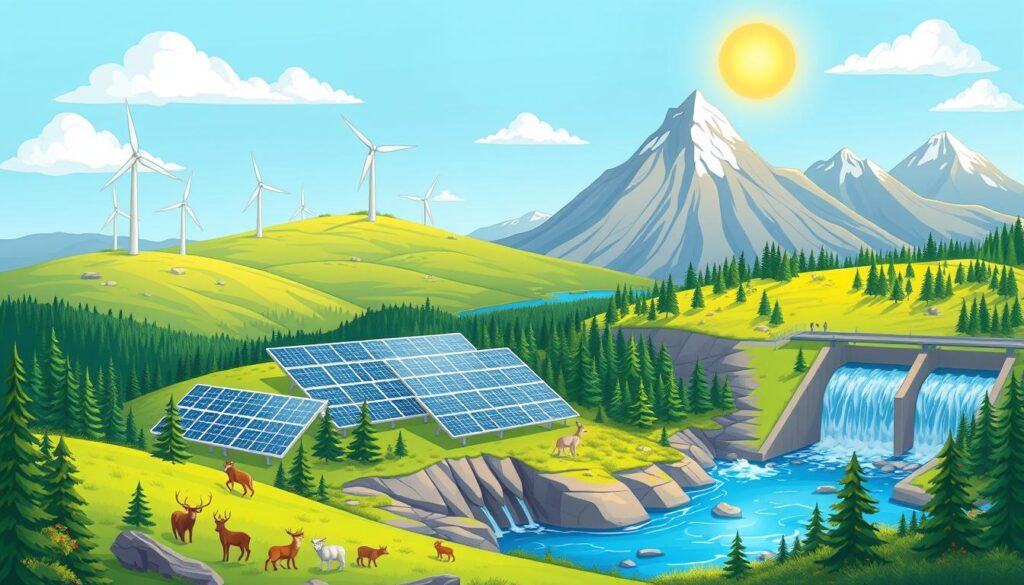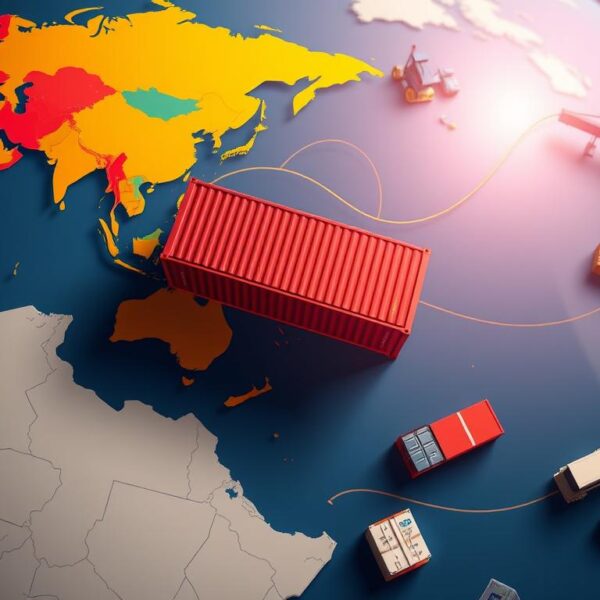Canada is leading the fight against climate change with its clean electricity. Over 80 percent of its power comes from green sources. This makes Canada a global leader in clean energy.
Canada is a top producer of hydroelectricity and has a strong nuclear program. Wind and solar energy are also growing fast. The goal is to make all electricity carbon-free by 2035.
Key Takeaways
- Canada’s electricity grids draw over 80 percent of their power from renewable and non-emitting sources, making it one of the cleanest power systems in the world.
- The federal government is committed to fully decarbonizing Canada’s electricity grids by 2035, a significant milestone in the country’s path towards net-zero emissions by 2050.
- Renewable energy sources, such as hydroelectricity, nuclear power, wind, and solar, are playing a crucial role in shaping Canada’s green energy future.
- Collaborative efforts between the federal government, provinces, territories, Indigenous partners, and other stakeholders are essential to building clean, reliable, and affordable electricity systems across the country.
- The development of a comprehensive Clean Electricity Strategy in 2024 will be a critical step in guiding Canada’s renewable energy initiatives and achieving its net-zero goals.
Current State of Canada’s Clean Energy Landscape
Canada is leading the world in clean energy, with over 80% of its power coming from green sources. This makes it a top player in Green Energy Policies and Environmental Sustainability.
Hydropower is the main clean energy source in Canada, ranking it fourth globally. The country also has a strong nuclear program, adding to its low-carbon energy mix. Wind and solar are growing fast, thanks to Energy Transition Strategies.
Overview of 80% Non-emitting Power Grid
Canada’s power grid is 83% clean, thanks to hydropower, nuclear, wind, and solar. The country is also exploring new tech like carbon capture and hydrogen to improve Environmental Sustainability.
Key Players in Canadian Energy Sector
- Provincial utilities, such as Hydro-Québec, BC Hydro, and Manitoba Hydro, play a big role in clean energy development and distribution.
- Federal regulatory bodies, like the Canada Electricity Advisory Council, guide and oversee energy policies.
- Private sector companies, including renewable energy developers and tech providers, drive innovation and investment in Green Energy Policies.
Regional Energy Distribution Systems
Clean energy distribution varies across Canada, with some areas more advanced than others. About 4 in 5 Canadians live in provinces with mostly clean electricity. But, places like Alberta, Saskatchewan, Nova Scotia, and remote northern communities face big challenges in switching to cleaner energy.
| Region | Non-emitting Power Share | Key Clean Energy Sources |
|---|---|---|
| Quebec | 99.8% | Hydropower |
| British Columbia | 98.2% | Hydropower, Wind |
| Manitoba | 97.6% | Hydropower |
| Alberta | 67.2% | Natural Gas, Wind |
| Saskatchewan | 65.1% | Natural Gas, Wind |
Economic Impact of Green Energy Transition
The shift to clean energy is crucial for our planet and a big economic chance. Canada’s renewable energy sector is growing fast. By 2050, the clean energy sector could be 63% bigger than the fossil fuel sector in 2025, even with inflation. This growth is thanks to the world’s need for Carbon Footprint Reduction and Canada’s role in Renewable Resource Management.
The clean energy sector’s GDP is expected to jump sixfold by 2050. This shows the huge Eco-Friendly Energy Solutions this change will bring. Clean electricity made up about 80% of new power in 2023. Electric cars were about one in five cars sold worldwide that year.
| Region | Clean Energy Contribution to GDP Growth (2023) |
|---|---|
| United States | 6% |
| China | 20% |
| European Union | Nearly 33% |
| India | Slightly less than 5% |
The clean energy shift is boosting the economy and creating jobs. In 2021, clean energy jobs beat fossil fuel jobs, and this gap is growing. The Inflation Reduction Act in the U.S. aims to add over 1.5 million jobs in the sector by 2032.
“The clean energy sector contributed significantly to total investment growth, with China attributing 50% and the United States 20% of the growth in total investment in 2023.”
As we focus on sustainable options, Canada is set for more economic growth and jobs. Its role in Renewable Resource Management will keep it prosperous and job-rich in the future.
Renewable Energy Initiatives: Federal Government’s Role
The federal government is key in shaping Canada’s renewable energy scene. It does this through policy, investment, and working with provinces. These efforts help Canada move towards a greener energy system and fight Climate Change Mitigation.
Policy Framework and Regulations
The government’s rules over power lines, nuclear power, and exports help create a strong policy for Sustainable Power Generation. It has a carbon pricing system and a 2030 Emissions Reduction Plan. These aim to encourage renewable energy and cut down on emissions.
A new Clean Electricity Strategy is coming in 2024. It will help build net-zero electricity systems across Canada. This strategy is key for Green Energy Policies and moving towards a clean energy future.
Investment Programs and Incentives
- The government offers many programs and incentives for renewable energy. This includes tax credits, grants, and loans for clean energy projects.
- For instance, the Renewable Energy and Energy Efficiency Partnership funds renewable tech projects across Canada.
- There’s also a $5 billion Clean Electricity Transmission Fund. It will help modernize and expand the national grid for more renewable energy.
Cross-Provincial Coordination Efforts
The government knows a united effort is needed for clean energy. It’s working on interprovincial power lines and sharing knowledge among provinces.
By doing this, the government is leading Canada towards a sustainable energy future. It’s making Canada a leader in Sustainable Power Generation and Climate Change Mitigation.
Provincial Leadership in Clean Energy Development
Across Canada, provinces and territories are leading the way in clean energy. Ontario is ending coal use, while Alberta is working hard to do the same. Each place uses its own strengths to help the country go green.
Utilities and energy regulators in provinces are key to clean energy plans. They help make the country more sustainable. They also boost the economy and create jobs in clean energy.
| Province | Renewable Energy Initiatives | Environmental Impact | Economic Benefits |
|---|---|---|---|
| Ontario | – Phased out coal-fired power generation – Investing in solar, wind, and hydroelectric projects |
– Significant reduction in greenhouse gas emissions – Improved air quality |
– Creation of thousands of green jobs – Attracting investment in clean energy sector |
| Alberta | – Transitioning away from coal-fired power – Expanding wind and solar energy production |
– Lowering carbon footprint – Promoting Environmental Sustainability |
– Diversifying the energy economy – Generating new employment opportunities |
| British Columbia | – Investing in hydroelectric and geothermal projects – Promoting the use of electric vehicles |
– Reducing reliance on fossil fuels – Protecting natural ecosystems |
– Becoming a leader in clean energy technology – Attracting investment and creating jobs |
Provincial efforts, with help from the federal government, are crucial for Canada’s clean energy goals. They are working together to make a greener future for everyone.
“The clean energy transition is not just about reducing emissions, but also about creating new economic opportunities and building a more resilient, diversified energy system.”
Job Creation in Clean Energy Sector
The clean energy industry is growing fast, creating many new jobs in the United States. In 2023, it added 142,000 jobs, making up more than half of new energy jobs. This growth is due to the need for Sustainable Power Generation, Eco-Friendly Energy Solutions, and Renewable Resource Management.
Employment Growth Projections
The clean energy sector is set to create 2.7 million jobs by 2050. It will grow at 7% each year. This growth will be much faster than the decline in fossil fuel jobs, leading to a greener future.
Emerging Career Opportunities
The clean energy revolution has opened up many new career paths. These include jobs in electric vehicle making, renewable energy, and energy-efficient buildings. These fields offer great opportunities for those wanting to help shape the industry’s future.
Skills Development Programs
- The U.S. Department of Energy (DOE) is working to standardize education and training for clean energy. This ensures a ready workforce for the sector.
- DOE’s Office of Energy Efficiency & Renewable Energy (EERE) is promoting diversity in clean energy research. It aims to increase diversity in the field.
- The Clean Energy Careers for All program will spend nearly $3 million on STEM education. It aims to help diverse groups find clean energy careers.
- The U.S. Department of Energy started a Battery Workforce Challenge Program. It trains a diverse workforce for jobs related to batteries and electric vehicles.
“The clean energy sector is focusing on creating good wages, benefits, worker protections, and the right to unionization.”
As the United States moves towards a sustainable energy future, the clean energy sector will be key. It will create jobs and drive economic growth. It offers many opportunities for those wanting to work in Sustainable Power Generation, Eco-Friendly Energy Solutions, and Renewable Resource Management.
Infrastructure Development and Grid Modernization
Canada is moving towards clean energy, and it needs new infrastructure and a modern grid. The old grid must be updated to handle more clean energy. This is key for reliable power across the country.
Expanding transmission lines is a big focus. It will help move renewable energy from remote areas to cities. Also, making the grid smarter is vital. This includes using advanced sensors and energy storage to manage wind and solar power better.
Canada has a chance to invest $2.1 trillion in the Indo-Pacific region. This includes Canada. Canadian tech and expertise can help the global clean energy shift. The government must support this effort with policies and funding.
- Over 9,200 electric generating units in the U.S. have a total generating capacity of over 1 million megawatts.
- The U.S. electric grid comprises more than 600,000 miles of transmission lines.
- Modernizing the electric grid can lead to a reduction in the frequency and duration of power outages, lower storm impacts, and faster service restoration.
Working together between public and private sectors is key for grid modernization. With the right laws and funding, Canada can build a better, greener energy system.
“The future of our clean energy transition depends on the modernization and resilience of our power grid. By investing in infrastructure and leveraging smart grid technologies, we can unlock the full potential of renewable energy sources and ensure a reliable, sustainable energy future for all Canadians.”
Indigenous Communities and Green Energy Projects
Canada is working hard to be more sustainable. Renewable Resource Management and Sustainable Power Generation are key parts of this effort. Indigenous communities are playing a big role, working together and finding new ways to make money.
Partnership Initiatives
In Canada, new partnerships are forming to include indigenous people in green energy. These partnerships mix indigenous knowledge with modern energy projects. They’re changing the way we get power and helping local communities grow.
Economic Benefits and Opportunities
Green energy projects are bringing jobs and money to indigenous communities. They’re creating jobs, sharing profits, and helping people learn new skills. For example, the Meadow Lake Tribal Council in Saskatchewan has a bioenergy plant that powers 5,000 homes.
But, there are still challenges. Communities face issues like lack of money, skills, and access to resources. It’s important to work together to make sure everyone benefits from green energy. This means respecting indigenous rights and involving them in the decision-making process.
“Renewable energy development must not happen at the expense of Indigenous people, highlighting the risk of a new type of ‘clean’ colonialism.”– Joan Carling, Expert
Environmental Impact and Carbon Reduction Goals
Canada is working hard to meet its climate goals. It wants to cut greenhouse gas emissions by 40-45% by 2030. The aim is to reach net-zero emissions by 2050, following the Paris Agreement.
Switching to clean energy is key. This change will help the economy go electric by 2050. It will greatly lower Canada’s carbon footprint.
When starting new renewable energy projects, Canada does environmental impact assessments. These checks make sure clean energy is used in a way that protects nature and wildlife. The U.S. Department of Energy also supports research to make renewable energy better.
Canada is set to lead in fighting climate change with more renewable energy. Using clean energy will not only cut emissions but also create jobs in the green sector.







